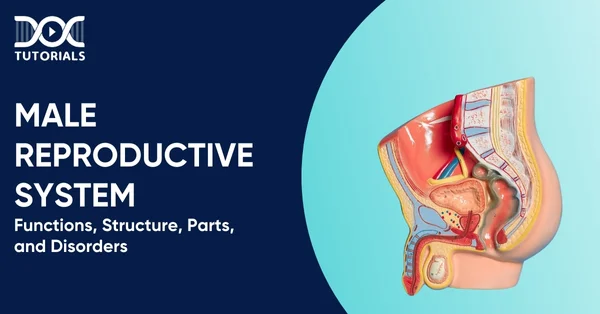Male Reproductive System | Functions, Structure, Parts, and Disorders

Both male and female reproductive tissues are developed in utero in a similar way. However, the difference between the female and male reproductive systems is caused by testosterone. The male gonads release testosterone, which forms male sexual tissues and organs such as testicles, scrotum, penis, etc.
The human male reproductive system diagram briefly explains anatomy and functions. However, if you are a medical student appearing for NEET PG exams, learning about the male reproductive system in detail is essential.
Keep reading to learn more about the male reproductive system, its functions, and its associated disorders.
What is the Male Reproductive System?
The male reproductive system includes both internal and external organs. Its main functions are to produce male sex hormones like testosterone, maintain and transport sperm and seminal fluid, and release sperm during sexual activity. The system is intricately connected with the urinary tract, sharing some structures, like the urethra.
Sperm is a crucial part of the male reproductive system. It fertilises the female reproductive cell to form a new species. Sperm is produced in the seminiferous tubules present in the testicles.
Parts of Male Reproductive System
The male reproductive system consists of both internal and external organs that perform different functions. Here they are:
- External Organs of Male Reproductive System
- Penis
The external reproductive organ that facilitates sexual activity and the passage of semen and urine is the penis. It has erectile tissue, which fills with blood to produce an erection.
- Scrotum
The scrotum, a skin pouch, holds and shields the testicles. It controls the testes’ temperature, which is essential for sperm production.
- Testes
The scrotum contains oval-shaped glands called testes. They produce the primary male sex hormones, testosterone and sperm.
- Internal Organs of Male Reproductive System
- Epididymis
Sperm mature and are stored in the epididymis, a coiled tube located at the rear of each testicle.
- Deferens
The muscular tubes known as the vas deferens carry mature sperm from the epididymis to the urethra to prepare them for ejaculation.
- Seminal Vesicles
Located behind the bladder, the main function of the seminal vesicles is to secrete fluid, forming a significant portion of semen.
- Prostate Gland
The walnut-sized prostate gland sits beneath the bladder and encircles the urethra. It produces a substance that shields and feeds sperm.
- Urethra
Urine and semen pass through the urethra, a tube that passes through the penis.
Functions of the Male Reproductive System
The following are the male reproductive system functions that contribute to reproduction and overall male health:
- Sperm Production
The testes generate sperm through a process called spermatogenesis. Sperm mature in the epididymis before being transported during ejaculation.
- Hormone Production
The testes produce testosterone, which is responsible for developing male secondary sexual characteristics, such as muscle mass, body hair, and a deeper voice.
- Semen Production and Transport
The seminal vesicles and prostate gland produce fluids that mix with sperm to form semen. The vas deferens and urethra transport semen out of the body during ejaculation.
- Sexual Function
The penis enables sexual intercourse and the delivery of sperm into the female reproductive tract.
- Urinary Function
The urethra serves the dual purpose of expelling urine and semen from the body, though not simultaneously.
Common Disorders of the Male Reproductive System
Several disorders can affect the male reproductive system, impacting fertility, sexual function, and overall health:
- Hypospadias
A congenital condition where the opening of the urethra is on the underside of the penis instead of the tip, often requiring surgical correction.
- Hydrocele
Fluid accumulation around the testicle causes swelling in the scrotum. This can cause discomfort and may require surgery.
- Varicocele
Enlarged and twisted veins in the scrotum, similar to varicose veins, can reduce sperm production and infertility.
- Cryptorchidism
Failure of one or both testicles to descend into the scrotum at birth. If uncorrected, it increases the risk of infertility and testicular cancer.
- Benign Prostatic Hyperplasia (BPH)
Non-cancerous enlargement of the prostate gland, common in older men, causes urinary problems such as difficulty urinating and increased frequency at night.
- Erectile Dysfunction
The inability to achieve or maintain an erection sufficient for sexual intercourse. Causes can be physical or psychological, and treatments vary.
- Male Infertility
It can result from various factors, including hormonal imbalances, genetic conditions, infections, or lifestyle factors.
FAQs About the Male Reproductive System
- What is the primary function of the testes?
The testes are responsible for producing sperm and testosterone, the primary male sex hormone essential for developing male characteristics and reproductive capability.
- How does sperm travel from the testes to outside the body?
Sperm are produced in the testes, mature in the epididymis, and travel through the vas deferens. During ejaculation, they mix with fluids from the seminal vesicles and prostate to form semen, which is expelled through the urethra.
- Can lifestyle factors affect male fertility?
Yes, factors such as smoking, excessive alcohol consumption, obesity, and lack of exercise can negatively impact sperm quality and overall reproductive health.
- What is a vasectomy, and can it be reversed?
A vasectomy is a surgical procedure that cuts or blocks the vas deferens to prevent sperm from reaching the semen, serving as a permanent method of male contraception. Reversal is possible but not consistently successful.
- How can men maintain a healthy reproductive system?
Maintaining a balanced diet, regular exercise, avoiding smoking and excessive alcohol, practising safe sex, and having regular medical check-ups are key to supporting male reproductive health.
Conclusion
Understanding the structure, function, and parts of the male reproductive system is necessary to take proactive steps towards reproductive and overall health. Early detection and management of disorders can significantly improve outcomes and quality of life.
If you are an NEET PG aspirant, a complete and in-depth knowledge of the male reproductive system is essential. With DocTutorials, you can learn everything about this topic through systematic study materials, detailed video lectures, timely assessments, and more.
Join our NEET PG course today!
Latest Blogs
-

NEET SS Exam 2024: Analysis, Key Dates, Counselling
The NEET SS 2024 exam kicked off on March 29, 2025. Over two days and two slots, candidates across 13…
-

NEET PG Registration 2025: An Essential Guide For Exam Prep
The NEET PG registration, which is conducted online, is a crucial step in the exam process. Filling out the NEET…
-

NEET PG Syllabus 2026: A Must-Have Complete Guide for Exam Success
The NEET PG Syllabus acts as one of the foundation stones for aspiring postgraduate medical students like you who are…




